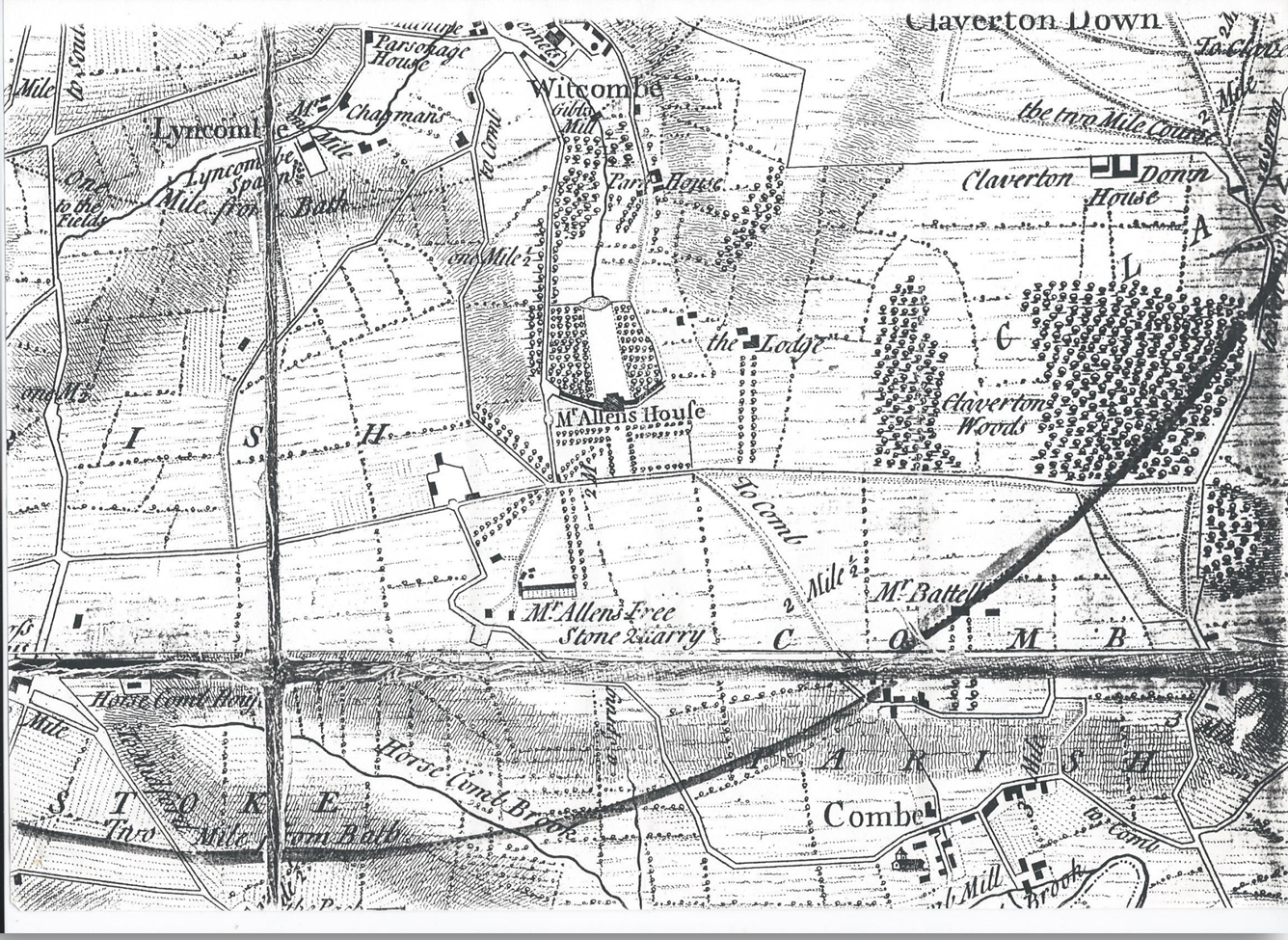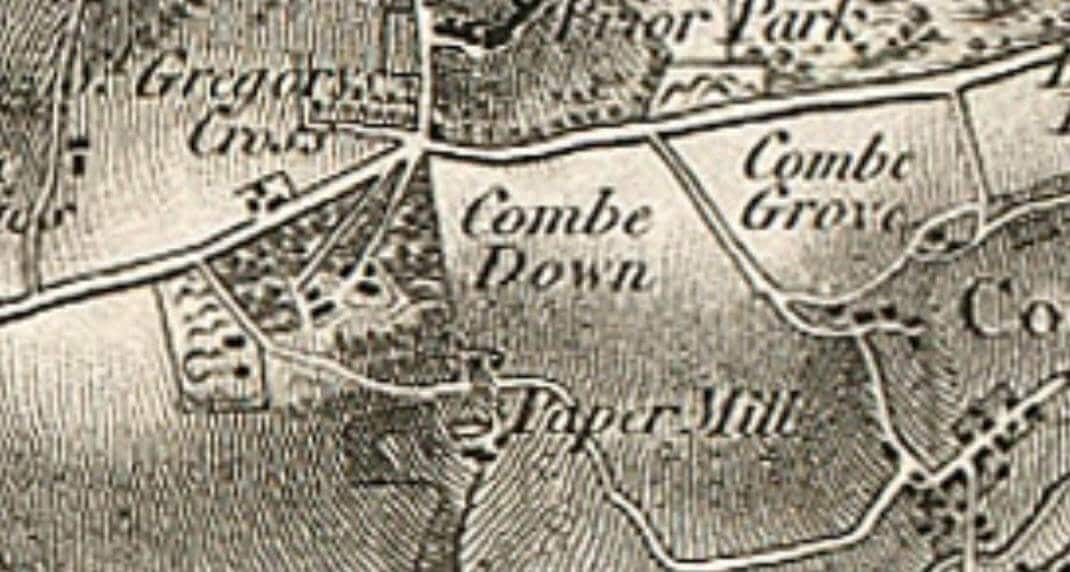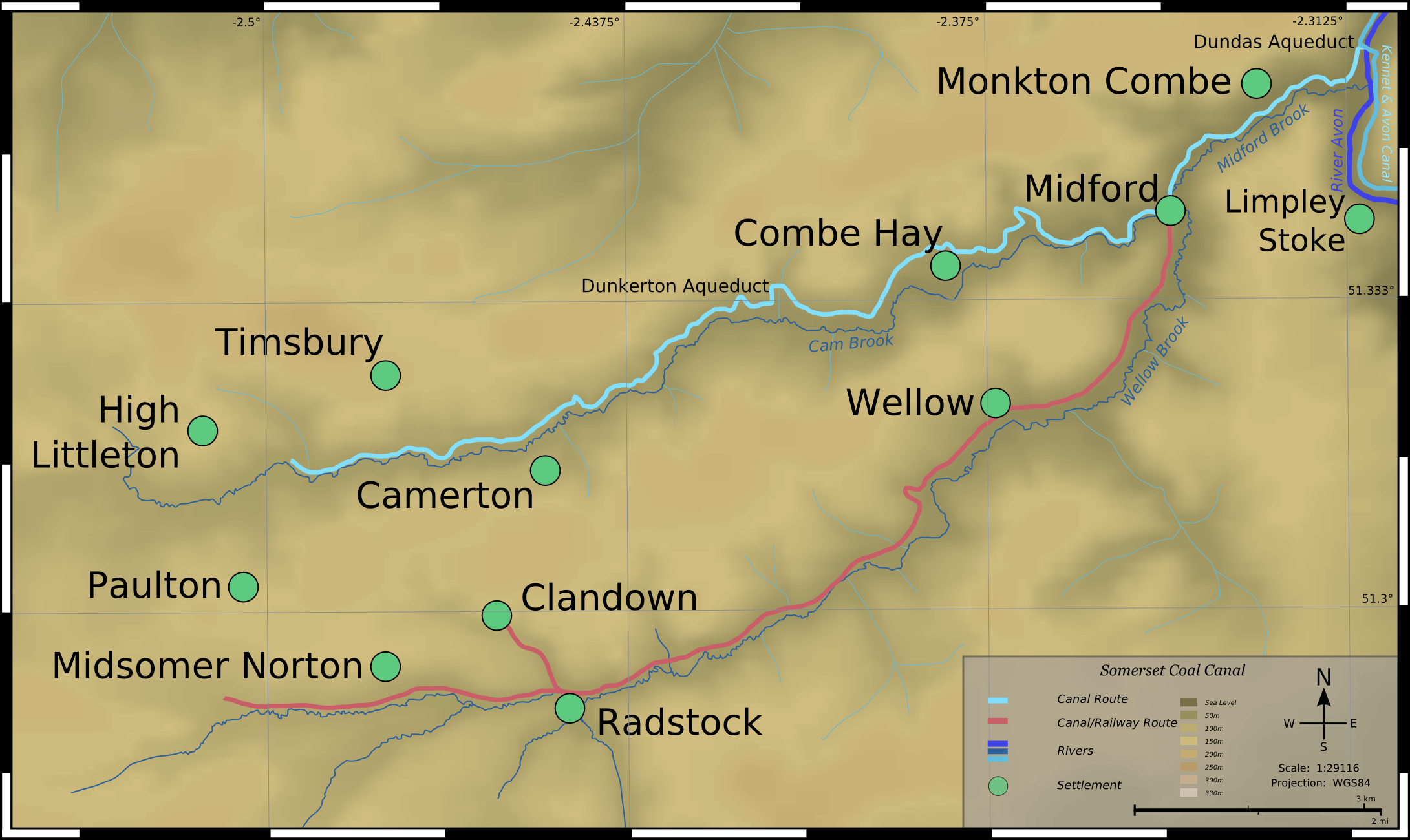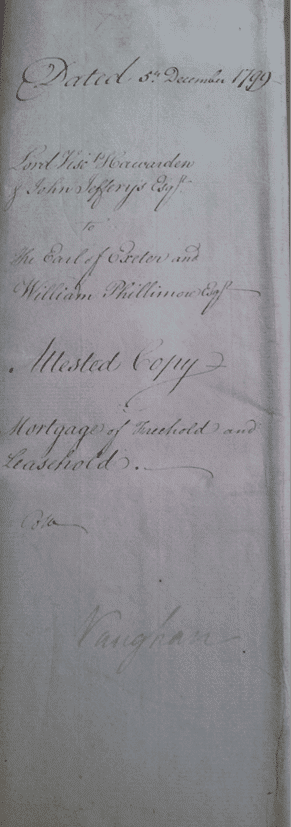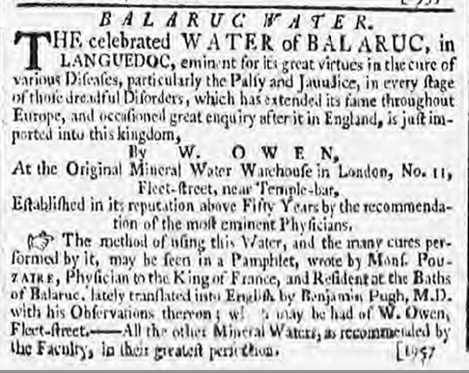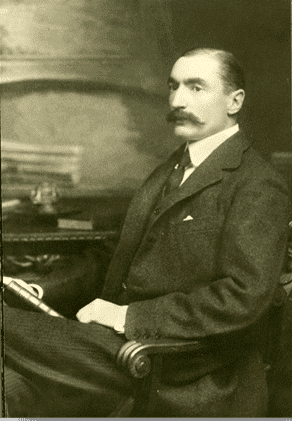1764 to early 1800s
1764 to the early 1800s
Before 1710 when Ralph Allen came to Bath, it was a small place. It is said that when Samuel Pepys visited in 1668 Bath’s population was less than 1,200 and there were only about 150 houses. By 1750 it was about 7,000 which reached 35,000 by 1801[1] making it one of the UK’s largest towns then.
His vision in seeing what could be done with the post office, and the profits he made from that and ploughed back into buying land and quarries, as well as philanthropy, helped to build Bath, but on Combe Down there was still little, as the maps show.
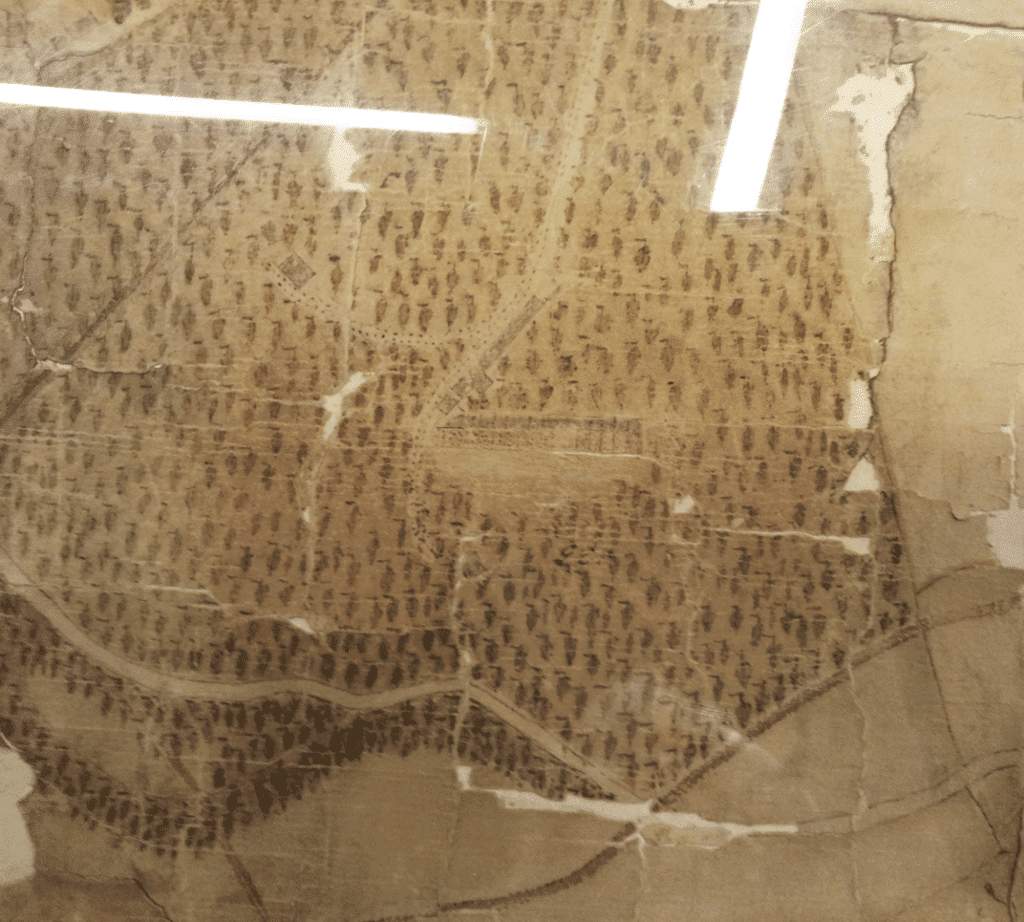
The original workmen’s cottages opposite Holy Trinity Church (De Montalt Place in Church Road) that he built between about 1729 and 1732, along with buildings in The Avenue where the newsagent (which was The Carriage Inn for the stone workers and sited just next to the Ralph Allen Wooden Railway that carried stone down to Widcombe) was situated in 2013, are the only buildings shown on the 1742 or 1761 maps, so we can be pretty sure that is all there was then.
So when was the building on rest of Combe Down started, how did it progress and who was responsible?
It certainly was not Ralph Allen (1693 – 1764) and although Mary Allen Lady Maude (1732 – 1775) and then Thomas Maude, 2nd Viscount Hawarden (1767 – 1807) each in turn became the heir presumptive in 1775, Thomas Maude, 2nd Viscount Hawarden (1767 – 1807) was then just 8 and under his father’s guardianship whilst Gertrude Tucker (abt 1727 – 1796 ) had control of the estate until 1796.
So what happened between 1775 and 1796?
In 1780, Mr. Rack, Secretary of the Bath & West of England Agricultural Society wrote:
"The entire village of Combe Down consists of 11 houses built by Ralph Allen in 1729, for his quarrymen." [2]
It seems little development had occurred by 1780.
On 28th May 1788 John Chapman, Ralph Allen’s surviving trustee conveyed to the Rt. Hon. Lord de Montalt & his trustee ‘Freehold Lands in Lyncomb and Widcomb & Monckton Comb Somerset’ for £9,515 3s 10½d. The record is a copy made by Benjamin Wingrove.
In the conveyance it says on pages 20 and 21: Thomas Ralph Maude’s birthday was 16th April so this is just after his birthday and in 1788 he reached his majority. Gertrude Tucker was now 62 and was to die in another 8 years; perhaps they realised the time for change had come?
“….and the remaining third part of the said three enclosures is all that close or piece of Ground containing Thirty eight acres on rood and eight perches bounded on the North by the said Turnpike road leading to Monckton Comb and other places on the South and West parts thereof by the said road leading to and from Monckton Comb and on the East partly by a Close of Ground formerly part of Comb Farm & called Poor Tyning and partly by a Close called Breach or Brow Hill on a part of which the dais Ralph Allen in his lifetime built the following row of houses now standing thereon and made or laid out Gardens thereto that is to say a Messuage or Tenement Brewhouse Garden and Premises now used and enjoyed therewith in possession of William Butler being a Public House at the yearly rent of fifteen pounds four shillings and six pence one other Messuage or Tenement and Garden and Premises used and enjoyed therewith by Mordecai Rolwell at the yearly rent of Two pounds one other Messuage or Tenement and Garden with the Appurtenances used and enjoyed therewith by William Birchall at the yearly rent of Six pounds sixteen shillings and six pence one other Messuage or Tenement Stable and Garden with the Appurtenances used and enjoyed therewithby Charles Davis at the yearly rent of Seven pounds and seven shillings one other Messuage or Tenement Coach-house Stable and Garden with the Appurtenances used and enjoyed therewith by Edward Morton at the yearly rent of five pounds one other Messuage or Tenement and Garden with the Appurtenances used and enjoyed therewith by William Birchall and Mr. Roth or one of them at the yearly rent of four pounds and four shillings one other Messuage or Tenement Outhouse and Garden with the Appurtenances used and enjoyed therewith by Thomas Guest at the yearly rent of seven pounds seven shillings one other Messuage or Tenement and Garden with the Appurtenances used and enjoyed therewith by Mrs. Dinah Skrine at the yearly rent of six pounds one other Messuage or Tenement Garden and Appurtenances used and enjoyed therewith by William Orchard at the yearly rent of six pounds and Six shillings one other Messuage or Tenement Garden and Appurtenances used and enjoyed therewith by Mr. Robert Ward at the yearly rent of six pounds and six shillings one other Messuage or Tenement and Garden with the Appurtenances used and enjoyed therewith by Thomas Ward at the yearly rent of four pounds one other Messuage or Tenement and Garden with the Appurtenances used and enjoyed therewith by Mr. Grant at the yearly rent of six Guineas and one other Messuage or Tenement and Garden with the Appurtenances used and enjoyed therewith by William Warren at the yearly rent of six pounds and six shillings and all those eleven acres on rood and twenty perches of arable land on Comb Down now and enclosure and called or known by the name of Kingham Field containing the measure aforesaid, more or less, bounded on the North by other lands of the said Ralph Allen hereinafter mentioned on the East by other lands of Samuel Charmbury and on the South by lands late of the said Thomas Shute and now of the Reverend Mr. Graves and on the West by Lands of the said Ralph Allen and Thomas Ward And also all that Land at……”
Thus, it seems that in 1788 Combe Down still consisted of the pub and workers cottages.
This seems to be confirmed in Around Combe Down by Peter Addison where he quotes Collinson’s History of Somerset, published in 1791, and describes the village of Combe Monkton:
"On the summit of Combe Down, a mile Northward from the church, (i.e. Monkton Combe Church) among many immense quarries of fine freestone, are large groves of firs, planted by the late Ralph Allen, Esq., for the laudable purpose of ornamenting that at that time rough and barren hill. Among the groves is a neat range of buildings belonging to this parish. It consists of 11 houses built of wrought stone raised on the spot, each of which has a small garden in front. They were originally built for the workmen employed in the quarries but are now chiefly let to invalids from Bath, who retire hither for the sake of a very fine air (probably rendered more salubrious by the plantation of firs), from which many have secured essential benefit. The surrounding beautiful and extensive prospects, the wild but pleasing irregularities of the surface and scenery, diversified with immense quarries, fine open cultivated fields, and extensive plantations of firs, which throw a solemn gloominess of shade, impervious to the sun and wind, over a fine soft turf free from underwood - all seem to render this a delightful summer retreat..............".[3]
It seems little development had occurred at Combe Down village by 1791, though further down the hill construction of a ‘Georgian motorway’ – The Somerset Coal Canal – was about to proceed apace.
From their 1924 history of Combe Down, D. Lee Pitcairn and Rev. Alfred Richardson state that:
“The houses in Isabella Place were built about 1800, and in 1805 when the De Montalt Mills were founded cottages were erected in Quarry Bottom and Davidge’s Bottom to take the place of wooden booths which labourers and workmen had hitherto occupied for the day and in which they had sometimes slept during the week. From this time onwards the place began to develop little by little… In 1829 when the Combe Down quarries were disposed of by Mrs. Cruickshank, building further increased…”
We can also read an interview with ‘Old John’ Greenway, a stonemason, published in Bath Chronicle and Weekly Gazette on Thursday 19 March 1896. ‘Old John’ was 94 at the time and had lived on Combe Down since he was an infant and in the same house (in Rock Cottages on Rock Lane) on Combe Down for 67 years since 1829. He states clearly that that by the early 1800s there were “only 13 cottages besides the houses in the Old Rank” (De Montalt Place).

Indeed the undeveloped nature of Combe Down can be seen from the detail from Ordnance Survey First Series, Sheet 19 1817, 1 to 63360 below. Though it is quite blurry it is clear that there was little housing and in the central area of the village North Road, Combe Road / Summer Lane, Rock Lane, Isabella Place, De Montalt Place and The Avenue are all clear along with drungs, pathways or roads no longer in existence.
Buildings are indicated near Byfield, Rock Lane, Isabella Place, The Avenue and De Montalt Place.
From my research I suspect that the 13 houses mentioned by ‘Old John’, other than the 11 at De Montalt Place, include the 5 of Isabella Place, Claremont House (now 109 Church Road), the 4 houses that were originally at what is now the 3 houses at 113 – 117 Church Road (the one between Union Chapel and 113 burned down sometime between construction in 1805 and 1836, probably about 1820) and the 3 houses that were 1 – 3 Claremont (now Hope Cote Lodge) all 13 of which were built in 1805 (along with the De Montalt Mill) as Thomas Maude, 2nd Viscount Hawarden tried to clear the debts of his father Cornwallis Maude, 1st Viscount Hawarden.
Monkton Combe lock up
Monkton Combe lock up
The lock up at Monkton Combe has two cells and was built around 1776 and, until about 1900, there used to be stocks outside. It was repaired in 1897, restored in 1954 and a new door was fitted in 1968 and further work in 2003. On 27 November 1953 the lock up was listed an Ancient Monument.
Before there was a police force rural communities had to police thefts, burglaries, drunkenness, livestock theft and a host of other crimes themselves. A lock up was used for the temporary detention suspects who had to appear before the local magistrate and might abscond. Lock ups started to fall out of use with the County Police Act 1839 as local police stations were built with their own holding facilities. Bath actually formed its own police force in 1836 after the Municipal Corporations Act 1835. However it was not until County and Borough Police Act 1856 that the Somersetshire Constabulary was formed. It was combined with Bath City Police in 1967 and that in turn merged seven years later with a number of other forces to become the Avon and Somerset Constabulary.
Somerset Coal Canal
The Somerset Coal Canal
The southern boundary of the Combe Down is the Midford Brook and running parallel and just above this is the Somerset Coal Canal.
In 1763 coal was discovered in Radstock but transport was a major problem leading to the proposal for a canal. Initial surveys during 1793 by William Jessop (1745 – 1814) and William Smith (1769 – 1839) under the direction of John Rennie (1761 – 1821) estimated the cost of construction of the canal at £80,000.
The Somerset Coal Canal (SCC) was authorised by an Act of Parliament in April 1794.
'An Act for making and maintaining a navigable Canal, with certain Railways and Stone Roads, from several Collieries in the county of Somerset, to communicate with the intended Kennet and Avon Canal, in the parish of Bradford, in the county of Wilts' and incorporates a number of persons therein named by the title of "The Company of Proprietors of the Somersetshire Coal Canal Navigation" and authorizes them to raise, for the purposes of the act, the sum of £80,000, in eight hundred shares of £100 each; and, if necessary, a further sum of £40,000, either amongst themselves or by mortgage of the tolls as security. This was followed by a second act of parliament in 1796, entitled, 'An Act to vary and alter the 'Line of a Canal authorized to be made by an Act, passed in the Thirty-fourth Year of the Reign of his present Majesty, and to alter and amend the said Act'. The last act of parliament relating to this undertaking was passed in 1802, entitled, 'An Act for enabling the Company of Proprietors of the Somersetshire Coal Canal Navigation to vary and alter the Lines of the said Canal and Works, and to alter and amend the Powers and Provisions of the several Acts passed for making the said Canal'. It states that the sums of £80,000 and £40,000 authorized to be raised under the former acts respecting this navigation, have been contributed amongst themselves and expended in the prosecution of the work, and that the shares have consequently become of the value of £l50 each.[3]
"This canal unites with the Avon and Kennet canal at Bradford, Wilts, near Stoke Limley, and parallel with Mitford Brook to Mitford Mill, where two cuts branch off, one goes to Coombe Hay, through a tunnel of a mile long to Dunkerton, Camerton, and High Little ton, being 8 miles. From Mitford Mill it rises 138 feet; the other cut goes by Wellow, Foxcote, Writhlington, and proceeds about a mile past Radstock to the collieries at Welton, in Somersetshire, 7+ miles, and 138 feet rise...By this canal Bath and Bristol will receive a constant supply of coal from the coal works the cuts are made to, as well as the inhabitants of other towns and large villages where it is much wanted."[5]
In May 1795 tenders were invited for the first section of the canal which was completed by October 1798 and it was completed and fully open by 1805. By the 1820s the canal was carrying over 100,000 tons of coal per year but the coming of railways changed the economics and by 1871 it was sold to the Somerset and Dorset Joint Railway Company who built their Bath to Evercreech line over much of its course. The company was placed in the hands of the Official Liquidator in 1894. In 1904 the abandoned canal was sold to the Great Western Railway, who, in 1907 – 10, built the Camerton to Limpley Stoke railway line over much of its course. These railways have now closed: the G.W.R. branch in 1951 and the S.& D. in 1966.[6]
Money troubles
Lord Hawarden’s Mortgages
By 1799 another problem had arisen in the life of Cornwallis Maude, 1st Viscount Hawarden.
On 5 December 1799 there is a mortgage between Lord Viscount Hawarden, John Jeffreys Esq.,[7] the Earl of Exeter[8] and William Phillimore Esq.[9] for freehold and leasehold properties. One of the witnesses to the mortgage is Benjamin Wingrove.
It seems that Cornwallis Maude, 1st Viscount Hawarden (1729 – 1803) had, on 14 March 1794, borrowed £4,000[10] from John Jeffreys mortgaged on some land. Then, on 15 March 1797 he had taken out a further loan of £1,347[11]. He also borrowed a further sum of £250 8s 7d[12] and then, ‘on or about’ 7 July 1798, had borrowed a further amount of £677 4s[13]. On 2 August 1798 he had had taken out a further sum of £800[14]. All these amounts were borrowed at 5% interest p.a.
So Cornwallis Maude, 1st Viscount Hawarden was now indebted to John Jeffreys for £6,366 13s 7d[15] secured:
‘by Mortgages and Surcharges as aforesaid on the respective freehold and leasehold Messuages…..’
It also seems that he had not paid the interest and the total owed was £7,669 8s 11d[16].
Then, on 24 September 1778, Cornwallis Maude, 1st Viscount Hawarden had borrowed £1,000[17] from The Earl of Exeter (then just Henry Cecil but later to be 1st Marquess of Exeter) and John Cope Freeman.[18]
So Cornwallis Maude, 1st Viscount Hawarden now owed The Earl of Exeter and William Phillimore £10,939 9s 1d [19] and also owed John Jeffreys £7,669 8s 11d, a grand sum of £18,008 18s.Not only that, but he had borrowed, on 30 May 1778, some £9,839 9s 1d[20] from The Earl of Exeter and William Phillimore and it seems that amount was secured on the same property as that noted in the conveyance of ‘Freehold Lands in Lycomb and Widcomb & Monckton Comb Somerset’ for £9,515 3s 10½d on 28 May 1788. In other words, the same land on which the mortgages of John Jeffreys were secured!
Which ever way you look at it this is a lot of money. In 2011, the relative worth of £18,008 18s from 1799 was[21]:
- £1,450,000 using the retail price index
- £1,530,000 using the GDP deflator
- £19,200,000 using average earnings
- £20,500,000 using per capita GDP
- £83,200,000 using share of GDP
It seems Cornwallis Maude, 1st Viscount Hawarden was:
…. “desirous of paying the said John Jeffreys his said Principal Monies and Interest and he not having monies sufficient for that purpose the said Henry Earl of Exeter and William Phillimore at the request of the said Cornwallis Lord Viscount Hawarden and to enable him to pay of and discharge the said sun of Seven thousand six hundred and sixty nine pounds eight shillings and eleven pence so due and owing from him to the said John Jeffreys as aforesaid and to supply his other occasions have agreed to lend him the said Lord Viscount Hawarden the sum of Twelve thousand six hundred and sixteen pounds on shilling and ten pence four per cent Consolidated Bank Annuities upon his undertaking to secure the transfer thereof with Stock Interest in the mean time and also to further secure the payment to them of the said sums of Nine thousand eight hundred thirty nine pounds nine shillings and one penny and One thousand one hundred pounds sterling and the interest thereof by the Bond of him the said Lord Viscount Hawarden and by and out of all the Freehold and Leasehold Hereditaments and premises hereinbefore and after mentioned and conveyed”.
So, he was using another loan from The Earl of Exeter and William Phillimore to pay off John Jeffreys and in turn giving them a clear mortgage title to the lands mentioned. There is one other thing that stands out in the document[22]. He had mortgaged Prior Park Mansion and Estate itself as part of the ‘deal’ in 1794.
Looking at what is mentioned other than Prior Park, at least a part of the land in question appears, essentially, to be the same land mentioned in the 1788 conveyance[23]:
“….and the remaining third part of the said three Inclosures was all that Close or piece of Ground containing thirty eight acres one rood and eight perches bounded on the North side by the said Turnpike road leading to Monckton Comb and on the East partly by a Close of Ground formerly part of Comb Farm called Poor Tyning and partly by a close called the Breach or Brows Hill on a part of which the said Ralph Allen in his lifetime built the following Row of Houses now standing thereon and made or laid out Gardens thereto (that is to say) A Messuage or Tenement, Brewhouse Garden and Premises then used and enjoyed therewith in possession of William Butler being a public house at the then yearly rent of……….”
and continuing to list the houses as per the 1788 Conveyance.
Given the evidence in the 1799 mortgage it would seem that Cornwallis Maude, 1st Viscount Hawarden had been spending a lot of money.
That money could have been spent on further building Combe Down, but from the feeling and tone of the document I doubt it. There is no sign of land improvement or building in the mortgages recitations of what was there. It seems that Cornwallis Maude, 1st Viscount Hawarden had money problems!
Thus, it would seem that by 1799 little had changed at all on Combe Down since Ralph Allen had died.
This was all about to change.
Midford Castle
Midford Castle
Although Midford Castle is not strictly a part of Combe Down, it is so close and has a history that intertwines that mention must be made of it and its owners and occupiers.
Henry Woolhouse Disney Roebuck
Midford Castle was built in 1775 by Henry Woolhouse Disney Roebuck (1733 – 1796). He was born Henry Woolhouse Disney but when his older brother John died without issue he became his grandfather’s heir, inheriting an estate at North Muskham near Newark on Trent in Nottinghamshire. He also came into possession of his maternal uncle’s property and so assumed the name of Roebuck.[24] This included estates in Broomfleet, West Hardwick, Leeds, Rawcliffe, Armin, Barnsley, Tinglaw, Churchwell, and Wakefield; stock in Aire and Calder Navigation; messuages and lands in Wragby, West Ardsley, Woodkirk alias Woodchurch, Warmfield cum Heath.[25] He also bought land in Ickford, Buckinghamshire from the Honourable Augustus Richard Butler, second son of the 2nd Earl of Lanesborough.[26]
It is thought that he had seen a design by John Carter in Builders Magazine in 1774 and used this for the plan of Midford Castle, which is a triangular design of three conjoined circular towers. It is unlikely, as is sometimes stated, that he won it or paid for it from winnings from a card game, as the porch that turns the design into an Ace of Clubs from the air was added later.[27] His paternal family had originally spelled their name De Isney. This is a town near Bayeux and they had come to Britain with William the Conqueror. He had granted them lands in Lincolnshire and they had gained lands in Nottinghamshire, Essex and elsewhere. Henry Woolhouse Disney Roebuck’s ancestors include: Edward I, King of England (1239 – 1307) 13th and 14th great grandfather, Edward II, King of England (1284 – 1327) 13th great grandfather, Edward III, King of England (1312 – 1377) 12th great grandfather. He had become a barrister of Lincoln’s Inn Fields, Middlesex.[28]
He put it up for sale in 1787.[29] In 1778 he had married his second wife, Elizabeth (d.1821)[30]. They clearly had quite a stormy marriage as he had placed immediately above the sale advert another personal advert denying the supposed claims of his wife to the estate. He had previously placed another advert saying she had left him and no one should extend credit to her in his name [31]
In fact in November of 1787 they went to court in Roebuck v. Roebuck. His wife served him with a write of ‘ne exeat regno’ – a writ to restrain a person from leaving the kingdom – for:
“a quarter’s arrears and upwards of her alimony of £150 a year being unpaid, and a suit having been instituted by her for an increase of alimony.”[32]
The case went as follows:
“…in the year 1778 the petitioner intermarried with the defendant, who was then seised or possessed of a very large and considerable fortune, consisting of several freehold estates in the counties of York, Herts, and Somerset, in the bill filed in this suit particularly mentioned, and of large personal property, producing together an annual income of £2000 and upwards. That the petitioner has had four children, all sons, by the said defendant, since their intermarriage, three of whom are still living; and that they lived on terms of harmony together for some time, and until about the year 1784, when the said defendant began to behave and conduct himself towards the petitioner with ill-nature, and which was followed by him with various acts of unkindness and ill-usage to the petitioner; and afterwards the said defendant determined within himself to get rid of the petitioner by any means, however unjust and prejudicial to her; and finding that — notwithstanding his cruel treatment of her — she was determined not to quit her family and children, the said defendant, in January, 1784, assisted with armed men, violently assaulted the petitioner in her bed chamber, in the mansion-house of the defendant, at Stanstead, in the county of Herts, where they then resided, and forced her out of doors early in the morning, without any comfort or conveniency provided for her in any other place; and she hath never since been permitted or suffered to live or cohabit with him. But the said defendant hath ever since lived separate and apart from the petitioner, and still continues so to do, and absolutely refuses to permit or suffer the petitioner to live with him. That ever since his separating himself from the petitioner she hath been in great distress, having no allowance or maintenance made by him, save and except in the instance hereinafter mentioned. That soon after the said defendant had forced the defendant away from him as before mentioned, he made a proposal and offer to allow the petitioner £400 a year if she would agree always to live separate and apart from him. But the petitioner — being conscious of the injury he had done her, and mindful of her reputation and character — refused the said offer. That the said defendant, having failed in such his attempt as aforesaid, and being resolved, if possible, to get effectually rid of the petitioner, he, in the year 1784, libelled the petitioner, in the Ecclesiastical Court, for adultery, and prosecuted the said suit to a hearing, upon which sentence was given in favour of the petitioner, and her innocency fully established. But from which sentence the petitioner has been advised to appeal to the Arches Court of Canterbury, for the purpose of obtaining an increase of alimony, and a divorce at her suit by reason of cruelty and adultery; and the said defendant has been duly served with process, notifying such appeal. That pending the said suit in the Ecclesiastical Court, the said defendant was, by such Court, ordered and decreed to allow and pay to the petitioner, for her maintenance, the yearly sum of £150, by way of alimony, to be paid quarterly; and the said defendant has accordingly paid great part of such alimony, but a quarter's arrears and upwards now remain due and unpaid, and which, from the circumstances hereinafter mentioned, the petitioner is in great danger of losing, as well also as every future support and maintenance from her said husband. That the petitioner hath lately instituted such suit in the said Arches Court, against the said defendant, for an increase of the said alimony or allowance of £150 in order to obtain a reasonable and competent maintenance and support suit able to the rank and fortune of the said defendant — which suit she is prosecuting, and which alimony the petitioner hopes will be considerably increased to the amount of £400 or £500 a year, regard being had to the considerable fortune of her husband, and which he enjoys to the extent before mentioned. That the said defend ant hath lately — and since such proceedings have been had in the Ecclesiastical Court as before mentioned — formed a resolution to go abroad, and there live upon and enjoy his property, or the produce thereof, and to defeat the petitioner both of the said alimony already decreed to her by the Ecclesiastical Court, and likewise of the increased additional alimony or maintenance she is now suing for as aforesaid; and the said defendant hath— in order the more effectually to carry such resolutions into execution, and to defeat her of every remedy against him — proceeded to make sale of all or the greatest part of his property, as well real and personal, and threatens that he will carry the whole produce thereof with him into some foreign parts, out of the jurisdiction of this Court, and that he will so do without making any provision, maintenance, or allowance for the support of the petitioner; as by affidavit appears. And forasmuch as the petitioner is advised that the said Arches Court of Canterbury have no jurisdiction over the person or property of the said defendant to compel him to give security to answer the petitioner's present allowance of alimony, and such increase of alimony as the said Arches Court may think proper to make to the petitioner, under the peculiar circumstances of her case; and without the aid and assistance of this Court the petitioner must be reduced to beggary and want, and receive support from her parish. That the petitioner has filed her bill in this court against the said defendant, as by the Six Clerks' certificate appears. His Honour — upon reading the Six Clerks' certificate of filing the plaintiff's bill, and the affidavits of James Patrick Kierman, Edward Foxcroft, and Gilbert Sheldon — doth order that a writ of ne exeat regno do issue against the said Henry Woolhouse Disney Roebuck, and that the same be marked in the sum of £600 and upwards, in words at length, and not in figures.” [33]
In some ways it seems quite ‘modern’ and perhaps it shows why he was selling Midford Castle.
When he died in 1796 his obituary was short:
“At Ingresss Park in his 63rd year, Henry Woolhouse Disney Roebuck, esq. He had been divorced from his lady; was fond of his pleasure boat, and was deemed one of the first gentleman-mariners of the age.”[34]
Benjamin Pugh
Midford Castle was bought by Benjamin Pugh M.D. (1718 – 1798). In 1784 he published:
“On the Climates of Naples, Rome, Nice, &c.; with some Advice to those intending to visit these Places in Pursuit of Health; by Benjamin Pugh, M. D.”
He was a surgeon from Baddow near Chelmsford in Essex.[35] In 1758 he had dissolved his partnership with another surgeon Christopher Griffinhoofe. [36]
By 1789 he was involved in the sale of Balaruc Water; the hot springs of Balaruc-les-Bains are among the warmest and the most mineralized in the Languedoc Mediterranean region. They contain trace elements that are said to have curative virtues. Balaruc is still a large spa town and it seems a little ironic that the water was being sold in Bath.
In 1802 after Benjamin Pugh had died Midford Castle was advertised again for sale.
The Conollys

It was bought in 1808[37] by Charles Conolly (abt 1759 – 1828)[38] who had made a fortune at the Chancery Bar. He went on to add land until 1812[39]. He was related to the Conolly’s of Castletown, Co. Kildare a prominent Irish family. He also went into a quarrying venture with William Smith, the father of British geology, more about which is written later.
In 1813 Midford Castle was described thus:
“It is situated on the declivity of a hill, which descends to the village of Midford, on the Warminster road. This structure stands on a bold projection, surrounded with elegant terrace plantations, which command, at different points, several picturesque views of the vale and surrounding hills. It was erected about thirty years ago, by Disney Roebuck, Esq. on a most curious plan, which combines the interior convenience of modern architecture with the dignity and grandeur of the ancient. Both the castle and the enclosures around it, how ever, are greatly indebted, for their present elegance, to the taste and judgment of Mr. Conolly. That gentleman, besides other improvements, has furnished the principal apartments with many valuable pictures of celebrated masters, and other curiosities. A very ancient Roman altar clock is particularly remarkable. On the North-East end of the pleasure-wood, the same gentle man has also constructed a very elegant building, called the Priory, which serves both as an ornament to the plantations, and to unfold the view of a beautiful glen, and several water falls, likewise of his formation.”[40]
After Charles Conolly died his son Charles Thomas Conolly (1791 – 1850) took over Midford Castle. He was married twice but had only one surviving son by his first wife Elizabeth (d.1827), who was first cousin to the Earl of Shrewsbury [41] He married again in 1828 to Jane Anne Lawless (1798 – 1871) daughter of a prominent Dublin brewer, Philip Lawless.
Philip’s brother was William Lawless (1772 – 1824), a surgeon who became involved in the United Irishmen movement and preparations for an uprising in 1798. He was about to be arrested but fled to Paris and entered the French army. He became a captain in the Irish Legion in 1803 rising to the rank of brigadier-general. He was awarded the Legion d’Honneur by Napoleon and lost a leg at the battle of Dresden.[42]
On 3 May 1837 Charles Thomas Conolly opened the chapel at Midford Castle. The priests came from Downside until 1841 when Prior Park stepped in. In September 1846 the Right Reverend Monsignor Dr. Charles Parfitt (1817 – 1886), an Anglican who had been baptised into the Catholic faith at Prior Park seminary in 1836, became resident missionary[43] and a great influence on Mrs. Conolly.
When Charles Thomas Conolly died his will left everything to his wife Jane.[44]
His son Charles John Thomas Conolly (1818 – 1871) had married Louisa Lucy Margaret Catherine Brancaccio (abt 1823 – 1899) who was made Marchesa di Sant Agata in 1857 by the King of Sicily,[45] in Naples in 1840. In 1857 he, or perhaps his stepmother, bought Cottles House in Atworth, Wiltshire which has been occupied since 1939 by Stonar School. The family lived at Cottles until her death. [46]
Midford Castle was put up for let unfurnished and[47] a George Robbins F.G.S. lived there from 1858 to at least 1869[48] when it was advertised for let again from September 1869.[49] It was let to Frederick William Charles Buxton Whalley (1811 – 1881), a barrister, until 1874.
Charles John Thomas Conolly and Jane Anne Lawless, his stepmother the second Mrs. Conolly, died within days of each other in 1871. Charles John Thomas Conolly died at Cottles on 9 February 1871 and Mrs. Conolly died at Cottles on 17 February 1871. His marriage was childless. If he had survived Mrs. Conolly, or had married and had issue, the property would have devolved upon him.[50]
Right Reverend Monsignor Dr. Charles Parfitt
However, under her will dated the 16 July 1862 she left the bulk of her property to the Right Reverend Monsignor Dr. Charles Parfitt, appointing him residuary legatee and sole executor. It caused quite a stir, and a court case, as he had been her chaplain and confessor, and is still used as a legal precedent.
Dr. Parfitt received the properties which were said to create an income of £7,000 p.a. although Mrs. Jane Conolly’s stepdaughter in law Louisa Brancaccio, Marchesa di Sant Agata (1823 – 1899) had a life interest in the estate.
Dr. Parfitt was responsible for starting the Combe Down waterworks, more details of which are given later. The validity of the residuary clause of the will was contested by Mr. Philip Lawless, an Irish barrister, who was Mrs. Conolly’s nephew and heir-at-law, on the ground that it had been obtained by undue influence. The evidence showed that Dr. Parfitt managed Mrs. Connolly’s property and her household and engaged and paid her servants and so the judge found for Dr. Parfitt and the will.[51]
After Dr. Parfitt died, in 1886, Louisa Brancaccio, Marchesa di Sant Agata continued to live at Midford Castle until her death in 1899. The contents of the castle were sold by auction later that year.[52]
In 1901 Dr. Parfitt’s trustees put the castle up for sale.[53] There was an auction on 26 June 1901 but the castle failed to reach its reserve, stalling at £9,500.[54]. The clipping from the Western Daily Press – Saturday 1 June 1901 shows the extent of the estate.
Captain Charles L. Ottley R.N.
In 1901 it was purchased by Captain Charles L. Ottley R.N., but he was the posted to St. Petersburg as naval attaché and so sold it on in 1902.[55]
Edwin Wilson Gresham Williams-Hepworth
The buyer was Major Edwin Wilson Gresham Williams-Hepworth (1842 – 1937). He had changed his name from Williams to Williams-Hepworth in 1881 by Royal License after his father-in-law John Mason Hepworth (1801 – 1880) left him Skelton Manor, a Stuart mansion just North of York, and the manorial rights including the right of Advowson or perpetual right of patronage to the benefice of Skelton which he had until his death when he willed it to the Archbishop of York.[56] His wife was Edith Helen Hepworth (1849 – 1943).
His father was General James Edwin Williams (1803 – 1885). He had been a general in the Madras Army of the Honourable East India Company which came under the authority of the Crown in 1858.
He had been in the 19th Hussars, commissioned as a 2nd Lieutenant in 1860 and reaching the rank of Major by 1880.[57]
After his death his wife offered Midford Castle for sale by auction in 1938. [58] Once again the reserves were not met.[59] It seems that Rebecca West (Dame Cicely Isabel Fairfield DBE (1892 – 1983)) the author and journalist considered buying it. [60] In November 1938 it was sold. [61]
Henry Arthur Whately
The buyer was Henry Arthur Whately (1855 – 1957).
Henry Whately was a barrister who was married three times. His father was Canon William Joseph Whately (1818 – 1909) who was rector of Rise in Yorkshire for 44 years from 1850 – 1894, but who died in Bath.[62]
He was married first to the Honourable Norah Creina Blanche Bruce (1859 – 1886) who was the fourth daughter of Henry Austin Bruce, 1st Baron Aberdare, GCB PC DL who was Home Secretary (1868–1873).
His third wife was Morna Sybil Chichester (1879 – 1951). She was the daughter of the Honourable Francis Algernon James Chichester (1829 – 1885). His second wife was Margaret Alice Edith Herschel Marshall (1861 – 1909). Her mother was Margaret Louisa Herschel (1835 – 1861). Her grandfather was Sir John Frederick William Herschel KH FRS (1792 – 1871), the mathematician, astronomer, chemist and experimental photographer/inventor. He was the son of Sir Frederick William Herschel KH FRS (1738 – 1822), the builder of telescopes and famous for his discovery of the planet Uranus, along with two of its major moons and also two moons of Saturn. He was also the first person to discover the existence of infrared radiation. He also composed twenty four symphonies and other musical pieces. He had a house at 19 New King Street in Bath where he made many telescopes and first observed Uranus, is now home to the Herschel Museum of Astronomy. Her uncle Sir William Herschel (1833 – 1917) discovered that finger prints were unique and developed the technique. Another uncle was Professor Alexander Stewart Herschel (1836 – 1907) who did pioneering work in meteor spectroscopy and identifying comets as the source of meteor showers.
During his ownership of Midford Castle he undertook extensive renovations and modernisation of the estate including the kitchen extension at ground floor level as well as plumbing and electrical works.[63]
Paul and Dorothy Baybut Peet
Midford Castle was bought by Paul Edward Albert Baybut Peet (1920-1997) and his wife Dorothy Higham (1924-1997) in 1959. He was a hairdresser trading as Paul of Mayfair in Milsom street and at Chippenham.
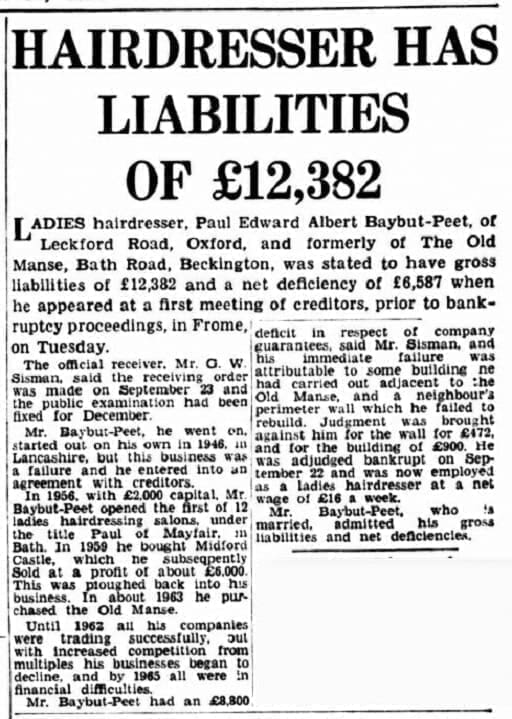
Michael and Isabel Briggs
In 1961 Midford Castle was bought by Michael Briggs (b.1926) and Isabel Colegate (b.1931) for £15,000.
Michael Briggs is a businessman and was part of the team that created the success of Rotork plc, becoming Deputy Chairman. He was also Chairman of The Bath Preservation Trust for many years and Isabel Briggs is an author (pen name Isabel Colegate) who wrote The Shooting Party, which was made into an award winning film, amongst others.
Isabel Colegate’s father was Sir William Arthur Colegate (1883 – 1956). He was educated at University College London and went on to become a civil servant before becoming a director of Brunner Mond and Co. until 1927. He was also a director of British Overseas Stores Ltd. and president of the Industrial Property Committee of International Chamber of Commerce 1925 – 1929. He was the Conservative MP for the Wrekin division of Shropshire 1941 – 1945 and the Conservative MP for the Burton division of Staffordshire 1950 – 1955. He was also a Fabian Society member and a research assistant to the Webbs.
Her mother was Winifred Mary Worsley, daughter of Sir William Henry Arthington Worsley, 3rd Baronet Worsley, and Augusta Chivers Bower. Through her uncle, Colonel Sir William Arthington Worsley, 4th Baronet Worsley, she is a cousin of Her Royal Highness The Duchess of Kent (Katharine Lucy Mary Worsley (b.1933)).
They spent 45 years restoring and improving the castle and its grounds.
Nicholas Cage (Nicolas Kim Coppola)
The Hollywood actor, director and producer Nicholas Cage (b.1964) bought Midford Castle in 2007 for around £4.75m. He never lived there but began an ambitious restoration programme, putting in a new roof and seeking planning permission to knock down internal walls and reinstate exposed stonework in the vaults. Tax problems meant that he decided to sell in 2009 losing over £1m on the purchase price.
Kenneth and Carolyn Scott Adams
The buyer was Kenneth Scott Adams (b.1961) who owns Wigan-based food supplement firm Nutrisport

